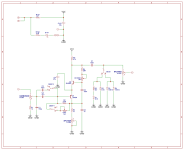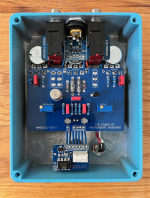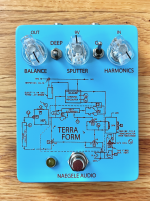PedalBuilder
Well-known member
After tracing the Latent Lemon Hurts, an interesting contemporary take on the venerable Interfax Harmonic Percolator, I laid out a couple of PCBs for a similar Harmonic Percolator build. I couldn't make up my mind as to whether I wanted to build a 1590BB2 pedal like the Hurts or whether I wanted a more compact 125B version. After hemming and hawing back and forth, I ended up getting both fabricated. I've really enjoyed the look of some Robert's recent PCBs with their curvy traces, so I leaned into that aesthetic for these builds.
I deviated somewhat from the Latent Lemon circuit in both builds. The actual circuit draws about 55µA, excluding the LED, so I was able to increase R101 from 47Ω to 4.7kΩ while only dropping the voltage by 0.28v. Theoretically it should reduce any noise coming in via the power rail. I added a 1kΩ limiting resistor to the Harmonics control so that it didn't mute the pedal when turned all the way down. I also replaced the 5M trim pot that the Hurts uses for the Q2 collector-base resistor with a 2.7M resistor and a 2M trim pot because the 2M is the largest 3296 that Tayda carries.
The two builds were largely identical, with a couple differences:
Here's the schematic that I used for my builds; gut shots are below.

1590BB2

125B

I deviated somewhat from the Latent Lemon circuit in both builds. The actual circuit draws about 55µA, excluding the LED, so I was able to increase R101 from 47Ω to 4.7kΩ while only dropping the voltage by 0.28v. Theoretically it should reduce any noise coming in via the power rail. I added a 1kΩ limiting resistor to the Harmonics control so that it didn't mute the pedal when turned all the way down. I also replaced the 5M trim pot that the Hurts uses for the Q2 collector-base resistor with a 2.7M resistor and a 2M trim pot because the 2M is the largest 3296 that Tayda carries.
The two builds were largely identical, with a couple differences:
- Transistors: Both builds used Texas Instruments 182505 germanium PNP transistors for Q1. The 1590BB2 build used one with a slightly lower gain (hFE 44, leakage 7µA) than the 125B build (hFE 57, leakage 13µA). That small difference was enough to make a very noticeable difference in sound and dynamic behavior. Despite having otherwise identical biasing (and identical silicon transistors for Q2), the 1590BB2 build is fuzzier and harmonic-laden, and never fully cleans up with the guitar's volume knob. The 125B build is more polite, for lack of a better term, and while it certainly fuzzes, it always sounds a little more polished and cleans up nicely as you roll back the volume knob. Both have a nice and very prominent suboctave undertone.
- Diodes: The 1590BB2 used 1N914 for the silicon clipping diodes; the 125B used 1N456. The 1N456 looks cooler, but both sound identical to my ears.
Here's the schematic that I used for my builds; gut shots are below.

1590BB2

125B

Attachments
Last edited:

